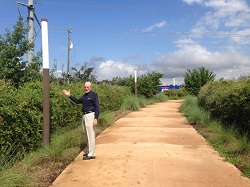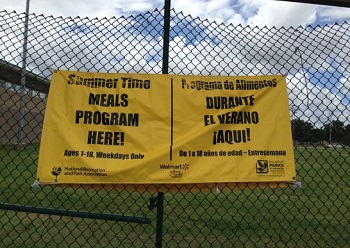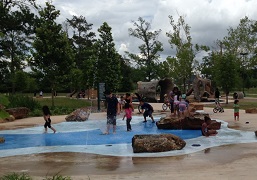We’ve shipped Kevin O’Hara, NRPA’s vice president of urban and government affairs, out of D.C. and all over the country to visit with some of the nation’s urban parks and recreation agencies to see how their innovation and leadership is shaping the future of cities and those that reside in or nearby.
He’s reporting back from these visits with some key takeaways that any park and recreation department can learn from no matter your size or location. His first urban spotlight, Houston, Texas.
When you think of Houston, Texas you think of your typical big Texas city. Heck, thousands of you were there for NRPA's Annual Conference last year and saw firsthand this incredible city and their beautiful parks.
But do you think of wild boar?
I didn’t think so either until I visited with the Houston Park and Recreation Department (HPARD).
For nearly 14 years, Director Joe Turner has overseen the stewardship and management of more than 37,832 acres of parkland and green space, numerous community centers, playgrounds, talented staff and budgets as big as, well, Texas.
Joe and his team also have the privilege of removing wild boar from their parks—how many urban park systems can say they do that?
Beyond the boar, on the day I arrived, the Houston Chronicle reported on an innovative agreement between the City of Houston and CenterPoint Energy to transform the space under and along power corridors into a multiuse trail corridor. CenterPoint sweetened the pot and included a $1.5 million donation to get the project off the ground.
Public-private partnership that leverages the myriad of community assets and interests characterizes the projects I saw during my visit to Houston, and illustrates the ethos and successes of HPARD Director and NRPA Board member Joe Turner.
Here are 5 takeaways from visiting with HPARD:
Houston is big!
HPARD has a service area of 656 square miles and a population of more than 2.2 million residents. From bustling multiuse rec centers, thriving community parks, to signature spaces that would be the envy of any city, Houston Parks and Recreation has a lot going on.
Every city should be so lucky to have a Buffalo Bayou.
Buffalo Bayou stretches 10 miles throughout the heart of the city. Envisioned in 1986, the Bayou project is a signature economic development and conservation initiative that is transforming how Houstonians interact with their bayous, parks and open space.
Houston gets green infrastructure.
At nearly 500 acres, Keith-Weiss Park straddles Halls Bayou and has created 111 acres of storm water retention, providing habitat for birds, turtles, beavers and possibly large reptiles. HPARD Natural Resources Manager Jed Aplaca showed how a partnership with the Harris County Flood Control District has created not only a functional space that controls flooding, but also a beautiful and wild space for Houstonians to get away and commune with nature.

A great example of green infrastructure is the “green bridge,” shown here with Director Joe Turner, connecting segments of Memorial park with a regional trail network (including the CenterPoint grant-funded power line trail).
Houston does health and wellness.
Denver Harbor Center is one of more than 450 feeding centers serving more than 1 million meals this summer. HPARD oversees the entire effort, thanks to the  diligence of Sheila Pous, senior community liaison-summer food programs and her team. At Denver Harbor, I saw 65 smiling faces chowing down on a healthy lunch after a morning of outdoor and indoor activities--jumping jacks, pull-ups, and just chasing one another around were among the ways this energetic group of kids worked up an appetite.
diligence of Sheila Pous, senior community liaison-summer food programs and her team. At Denver Harbor, I saw 65 smiling faces chowing down on a healthy lunch after a morning of outdoor and indoor activities--jumping jacks, pull-ups, and just chasing one another around were among the ways this energetic group of kids worked up an appetite.
Houston does social equity.
At Shady Lane Park I saw the power of NRPA’s efforts in action. At 4 o'clock on a Tuesday afternoon I saw a packed playground, spray pad and fitness zone. I saw kids exploring a path that detailed how water moves through the parks, I saw a neighborhood resident ask about starting a basketball league, and most importantly, I saw a lot of happy faces. From Zumba and aerobics classes, and educating the public about water and Houston’s bayous, I saw the lasting legacy that NRPA and other valuable partners have created making a difference in this community day after day. 
From the non-profit sector to park and recreation professionals throughout the region, there is a tremendous amount of human and social capital dedicated to creating, maintaining and improving greater Houston’s park and recreation infrastructure.
People such as Scott Johnson, the director of parks and recreation in Baytown, Texas; Jim Browne, director of parks and recreation in Sugar Land, Texas (and current TRAPS president); and Scott Swigert, director of parks and recreation in Deer Park, Texas, are all dedicated NRPA members committed to helping their communities and advocating for the profession in Houston and in Washington. These dedicated volunteers are spearheading innovative advocacy programs that are raising the profile of parks and recreation for all professionals.
On the non-profit side, I met Roksan Okan-Vick, executive director of the Houston Parks Board and Guy Hagstette, project manager for Buffalo Bayou Park of the Buffalo Bayou Partnership. They work hand-in-hand with HPARD to advocate for and fund monumentally cool new parks, trails and public spaces for Houstonians.
It is these dedicated park and recreation professionals and their community partners that are making Houston a great place for parks.
Kevin O’Hara is NRPA’s vice president of urban and government affairs.

